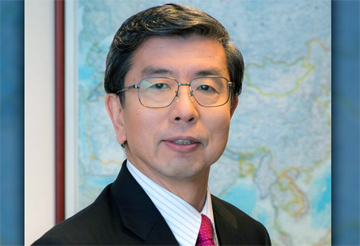DHAKA, Feb 28, 2018 (BSS) – Asian Development Bank (ADB) President Takehiko Nakao today pledged to strengthen further ADB’s 45-year partnership with Bangladesh and said the bank wants to be an important partner in the country’s development strides in the coming years.
“Bangladesh has been making progress and growing in many ways, including in macroeconomic situation and it’s also one of the highest growing countries in Asia. ADB wants to be an important partner of Bangladesh,” Nakao said in a crowded press conference at ADB local office in the city.
Mentioning that this was his 2nd visit to Bangladesh after the first one in June 2014, the ADB president said over the last four years, there has been very good progress in the macroeconomic situation of the country. The growth has been stable and the reserve is moving up while the inflation is in control, he added.
“The fiscal deficit is also managed. Overall, the country has made very steady progress in terms of growth,” he observed.
Nakao said ADB’s Country Partnership Strategy for Bangladesh proposes a total assistance of $8 billion, including for nonsovereign operations, during 2016-2020 period, 60 percent up from $5 billion in 2011-2015.
In 2016-2017, ADB approved $2.5 billion in sovereign and $600 million in nonsovereign assistance.
“To support the government efforts, ADB will provide additional resources depending upon need, performance of ongoing projects, and readiness of new projects,” he added
The ADB president said there has been a lot of progress in Bangladesh in terms in the fields of poverty reduction, health and education.
“Countries like Bangladesh need more money to invest in infrastructure, health and education. So, it’s important to continue to make efforts to raise revenues and also to raise the current tax-GDP ratio,” he added.
Noting that the export basket of Bangladesh is now heavily concentrated on the RMGs, Nakao underscored the need for diversifying the export basket, saying it would be a challenge for the country.
He said science and technology based education should be enhanced further in the country.
Expressing satisfaction over the current situation of power generation in the country, the top boss of the Manila-based lending agency said the situation is much better now compared to the situation five or 10 years back.
But, he opined, the country still needs more power to provide access to the poor people and to further promote industries. Asked if they have any plan to extend support to the forcibly displaced Rohingyas, Nakao said the ADB is prepared to support Bangladesh in this regard if there is any certain request.
He told another questioner that the ADB is yet to receive any request from the government regarding financing for the resettlement of the Rohingyas.
Referring to the process of graduation of Bangladesh from the LDC status to the developing nation, he said lending agencies like the World Bank and the ADB acknowledged that Bangladesh has already become lower middle income country and the Bank has no such plan for changing the lending terms right at the moment.
When asked whether ADB is ready to finance mega projects or the Padma 2nd Bridge project, Nakao said, “If there is any such request seeking funding for big projects, we’re ready to participate and of course, we can consider.”
He also mentioned that the ADB is ready to increase its lending as its total lending to Bangladesh since its partnership with the country totaled $ 20 billion which was $15 billion for years back.
About Bangladesh’s prospect for becoming a developed country by 2041, Nakao said, “It’s not impossible, but it’s not easy either.” For materializing that target, Bangladesh also needs to raise investment in education, infrastructure and health along with attracting more FDI and using its geographical location.
The ADB President said during his meetings with Prime Minister Sheikh Hasina and Finance Minister Abul Maal Abdul Muhith, he acknowledged Bangladesh’s impressive economic and social development over the last decade.
“The growth in these 10 years averaged about 6.3 % and reached 7.3 % in 2017. This high economic growth has enabled Bangladesh to attain middle-income status in July 2015 and helped cut poverty from about 49 % in 2000 to 24 % in 2016,” he added.
He noted that Bangladesh is on the track to continue its growth momentum and complimented the government for sound management of the economy.



